All RVs require some type of stabilizer jacks, from the smallest tent camper to large motorhomes. Pop-up tent and travel trailers need the stability of jacks to prevent the camper from rearing up when you walk to the back of the camper. And, properly deployed, the jacks not only stabilize the camper but also keep it level.
While the tongue or hitch jack may stabilize the front of the trailer, there are types of trailers and situations when support and stability are required at the front corners of a trailer. When this is the case, portable jacks may be practical.
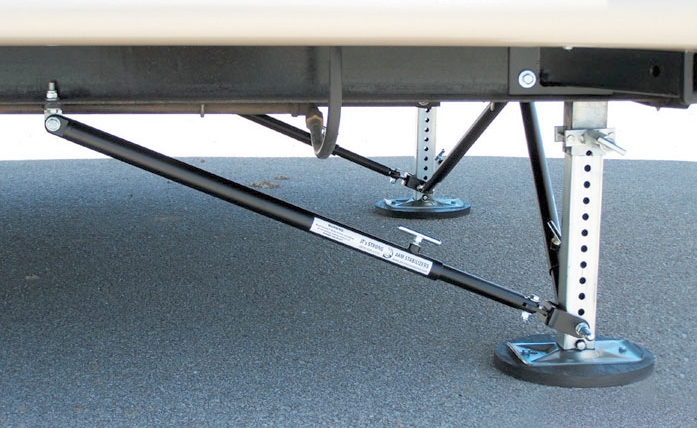 Source: pplmotorhomes.com
Source: pplmotorhomes.com
Jacks and stabilizer systems can be quite simple or complex and operated electronically.
Note camper jacks are designed for stabilizing the camper and not for lifting the camper off the ground, for example, to change a tire.
Types of Stabilizer Jacks
1) Screw Jacks
The simplest stabilizers are screw jacks. The base of the jack sits on the ground, positioned under the frame of a camper, usually near the rear corners. Using a handle attached to the screw, turn the jacking assembly up or down by turning the threaded screw post.
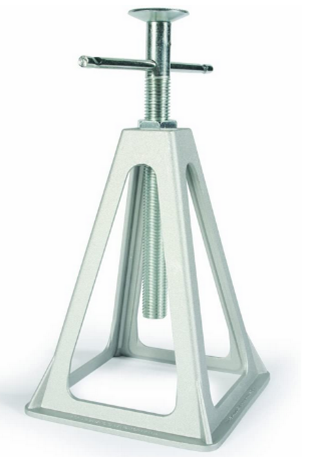
The advantage of screw jacks is that they are inexpensive, and they can be placed any where under the frame of the camper. For example, there are times when the rear of the camper may extend beyond the edge of the camp site. Screw jacks can be positioned a foot or two forward of the rear of the camper where there is solid support.
Screw jacks are practical to have on hand even if your camper is equipped with the latest permanently installed stabilizing systems. They are also handy if it is necessary to stabilize the front of a camper rather than rely on just the tongue jack to support the front.
2) Drop Leg or Drop-Down Jacks
Drop leg jacks are attached to the frame of the trailer near the corners. When not in use, they fold up against the frame of the trailer, out of the way.
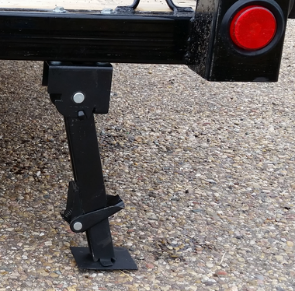
By releasing a locking pin, the stabilizer jack folds or drops down and can be extended until it touches the ground. Most drop down stabilizers have a method, usually a lever or foot pedal to push the foot of the stabilizer firm against the ground. To retract the drop down stabilizer, the same lever is used to release the catch that holds the leg in the down position, and the drop down portion is pushed back up against the trailer frame and snaps into position for travel.
3) Scissor Jacks
Perhaps the most common type of jack is the scissor jack. A threaded rod runs from one side of the jack to the other. As that rod is turned (using a crank handle), it pulls the hinged ends of the jack toward each other, pushing the hinged top and bottom of the jack farther apart—lifting the top against the trailer frame, or the foot of the jack onto the ground. These jacks can be permanently attached to the trailer, either by welding or using bolts and nuts. They are simple, dependable stabilizing systems.
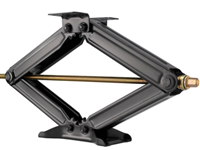
Scissor style jacks are often used as vehicle jacks to change tires, but it takes far less force to stabilize a camper than to jack up a car or trailer to change a tire.
Camper stabilizer jacks may not be manufactured to the same strength needed to lift a vehicle off the ground, and camper scissor jacks should not be used for tire changing unless they are specifically rated for the extra weight.
An extra pair of scissor jacks is a practical investment, especially if you camp away from public campgrounds. The extra jacks can help support the front corners of the camper rather than relying on the tongue jack for the front of the trailer. Some larger trailers come equipped with front scissor jacks.
4) Full Width Double Stabilizers
For the ultimate in convenience, you could install full-width stabilizer assemblies. Both sides of these stabilizers—either manually or electrically driven—are lowered at the same time. This simplifies setup of the camper. The double stabilizers reviewed here also can compensate for uneven ground, so the camper remains level even if the ground is not.

These are aftermarket devices and are adjustable to fit campers of different widths.
Buying Recommendations






1. Camco Olympian Aluminum Stack (Screw) Jacks – Editor’s Pick
Manufacturer Model No.: 44560
Attachment: N/A
Minimum Height: 11 in.
Maximum Height: 17 in.
Maximum Load: 6,000 each
Operation: Manual
Set: Four Jacks
Weight: 8 lb each
These stabilizers are made from durable cast aluminum and each can support up to 6,000 pounds.
Sold as a set of four.
Users like (1) the ease and simplicity of deployment and (2) the price.
- UNMATCHED RV STABILITY: Stabilize your RV with Camco's Aluminum Jack Stands for unmatched steadiness! This durable camper accessory prevents wobbling, ensuring a peaceful camping experience without unwanted movement.
- FAST, SIMPLE SETUP: Streamline RV leveling and stabilization effortlessly. Level your trailer, then place the jacks under your vehicle & adjust the height to make contact with the trailer.
- HEIGHT ADJUSTABLE: Easily adjust the height of this trailer accessory from 11" to 17" for stable support on any terrain. Raise each jack to the desired height for proper leveling and stabilization.
2. Drop Down Support Jacks
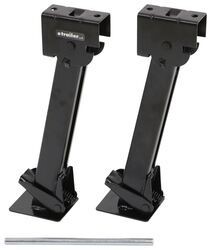 Source: etrailer.com
Source: etrailer.com
Manufacturer Model No.: 01892-2
Attachment: Bolt-on or Weld
Minimum Height: 7 in
Maximum Height: 22.25 in.
Maximum Load: 1,000
Operation: Manual
Set: Two Jacks and Ratchet Bar
Weight: 10 lb
These easy-to-use heavy-duty jacks are ideal for smaller trailers, including pop-up and smaller travel trailers, as well as utility trailers.
To operate, release the spring-loaded lever and the leg drops down and extends down to the surface. Use the lever bar to ratchet the leg firmly against the ground or pavement.
The large foot-pads ensure stability in even soft sandy soil.
Also use the lever bar to release the jack for travel, then fold the retracted leg up until it snaps in place.
The jacks can be bolted onto the camper frame—it may be necessary to drill holes in the camper frame. They may also be welded into position.
As with all stabilizer jacks, they are NOT intended to lift the trailer off the ground.
Users liked (1) the fact that the 22-in. extension is a bit longer than other similar jacks, (2) is easy to install, and (3) the fact that they steady a trailer when not connected to the tow vehicle.
3. Ark Camper Jacks
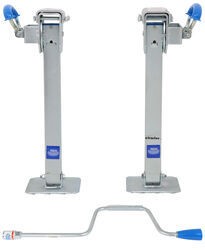 Source: etrailer.com
Source: etrailer.com
Manufacturer Model No.: AR94FR
Attachment: Weld
Minimum Height: 19 in.
Maximum Height: 30 in.
Maximum Load: 1,000
Operation: Manual
Set: Two Jacks and Ratchet Bar
Weight: 10 lb
Ark corner-mounted Camper Jacks are slightly longer, suitable for larger campers or for stabilizing the camper on uneven ground. Either way, they provide a solid foundation to support the camper.
The jacks have locking swivel brackets and large grip handles for easy swiveling. The large flat feet provide solid support on any surface. The foot plates can be removed if needed.
These jacks are designed to be welded to the camper frame. When retracted, the jacks fold up against the camper frame. The kit includes all materials and parts necessary to stabilize a camper or RV.
The jacks are easy to deploy. The “winding” handle is used to adjust the length of each jack for solid support.
The zinc finish is corrosion resistant and will maintain its appearance for years.
Users liked (1) the overall quality and (2) ease of use.
Scissor Jacks
1. Weize Camper RV Trailer Stabilizer Leveling Scissor Jacks – Editor’s Pick
Manufacturer Model No.: WEIZE
Attachment: Bolt-on or Welded
Minimum Height: 4 in.
Maximum Height: 24 in
Maximum Load: 5,000 per jack
Operation: Manual
Set: Two Jacks, Jacking Wrench
Weight: 26 lb
The minimum adjustment of 4 in. means they are tucked up close to the bottom of the trailer safely out of the way for travel, while the 24 in. extension provides excellent support when deployed. The “bow-tie” shaped feet provide solid support even on soft surfaces.
Users have the option of bolting or welding the jacks to their campers.
The jacks raise and lower quickly and smoothly using the provided jack handle.
People who purchased these liked the fact that they were (1) stronger and (2) more stable than the original equipment provided with their trailer.
- 【Scissor Jacks Features】: Extended height: 24 inch; retracted height: 4.7 inch; total length: 26.4 inch; width: 2.12 inch; 5000 pound weight capacity per stabilizer jack;
- 【High Materials】: Made of a high-quality steel, and the finish is treated with black powder coating, and the top support and bottom base are both treated with black electroplating, the trailer stabilizer leveling scissor jacks are stable enough to keep the chassis steady on the road;
- 【Easy to Operate】: These camper jacks use tooth gear design, you can lift or lower the height of the jack by shaking the gear in the middle, suitable for chassis of different heights;
2. LIBRA Set of 4 5000 lb, 24 in. RV Trailer Stabilizer Leveling Scissor Jacks
Manufacturer Model No.: 26020
Attachment: Bolt-on, Welded
Minimum Height: 5 in.
Maximum Height: 24 in
Maximum Load: 5,000 per jack
Operation: Manual
Set: Four Jacks, Jacking Wrench, Hardware
Weight: 40 lb
In addition to the jack handle, this set includes a ¾ in. hex magnetic socket that fits a quarter-inch drill to power the jacks up and down quickly.
The set includes a complete installation kit consisting of 16 3/8 in. mounting screws, a matching 9/16 in. socket, a 11/36 in. drill bit, and drilling guide stickers.
Each jack can support 5,000 lb. Libra claims that the grade of materials used in these jacks is the same as the material other manufacturers claim as able to support up to 7500 lb.
Users like (1) the fact that these jacks were heavier grade materials than their original stabilizers, (2) the drill attachment that allows a power drill to drive the jacks up and down, and (3) the convenience of complete mounting hardware and tools.
- Stablizing and leveling your RV/Trailer, Remains steady on soft surfaces because of wide bow-tie base
- Includes 4 steel jacks and a 3/4" hex magnetic socket to raise/lower jack faster by power drill!
- Complete installation kit included: 16 pcs 3/8" mounting screws & one matching 9/16" socket, a 11/36" mounting hole drill bit, one set of drilling guide sticker, everything you need for install!
Full Width Double Stabilizers
1. Ultra-Fab Power Twin II Manual Stabilizer Assembly
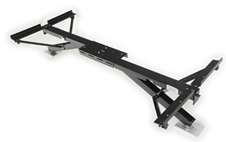 Source: etrailer.com
Source: etrailer.com
Manufacturer Model No.: UF39-941704
Attachment: Bolt-on
Minimum Height: 19 in.
Maximum Height: 30 in.
Maximum Load: 6,000
Operation: Hand Crank
Set: Two Jacks and Ratchet Bar Assembly
Weight: 58 lb
Simplify the set-up of your travel-trailer, 5th Wheel or motor home with this unique device. Designed to span the width of your rig for maximum support, the opposing sides of this stabilizer can be adjusted independently for effective leveling.
The sturdy steel assembly will support up to 6,000 pounds at heights up to 30 inches. The stabilizer is adjustable and can precisely fit campers from 48 in. to 80 in. wide.
The 36 in. wide support brackets are designed to be bolted to the camper’s frame.
When deployed, the jack stabilizes both front-to-back and side-to-side movement of the camper.
Extra large foot plates provide solid footing for all kinds of surfaces include loose dirt and sand.
Stabilizers are deployed with the included hand crank.
While this unit requires manual cranking, it can support much more weight than the electric unit described below. The unit is warranted for three years.
Users liked (1) that could be adjusted to fit their RVs and (2) the smooth manual extension.
2. Lippert Components High Speed Power Stabilizer Jack Kit (Electric)
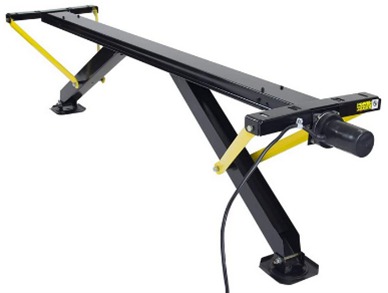 Source: etrailer.com
Source: etrailer.com
Manufacturer Model No.: 298707
Attachment: Bolt-on
Minimum Height: 19 in.
Maximum Height: 30 in.
Maximum Load: 2,000
Operation: Manual
Set: Dual Jack Assembly, Waterproof Switch, Reset Breaker, and wiring harness
Weight: 58 lb
What could be more efficient than a full-width stabilizing system that can be deployed electrically. The Lippert High Speed Power Stabilizer uses two powered drop-down stabilizers to simplify set-up. Stabilize your camper with the flip of a water-proof switch.
The stabilizer is 79 in. long, 6.2 in. wide, and the legs extend to 30 in. to support the vehicle.
Additionally, the automatic leveling system lets each leg operate independently to adjust for uneven terrain.
The frame of the stabilizer assembly is made of heavy gauge, powder-coated steel for durability and longevity.
Installation is simplified by bolting onto the campers existing frame.
This unit is covered by a one-year manufacturer’s warranty for added peace of mind.
Users like: (1) ease of installation, (2) rapid deployment, (3) overall quality, and (4) the yellow supports to help remind users that it is deployed and to raise the stabilizer before moving the vehicle.
3. Valterra RV Stabilizer
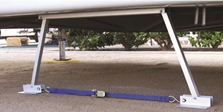
Manufacturer Model No.: 020106
Attachment: Tension
Minimum Height: 14 in.
Maximum Height: 28 in.
Maximum Load: n/a
Operation: Manual
Set: Frame and Adjusting Strap
Weight: 3 lb
The Valterra stabilizer is designed to work with other support systems to eliminate bounce and lateral (side-to-side) movement when entering, leaving, or moving about within the camper.
It eliminates annoying rattle and uncomfortable wobble, and it fits a variety of vehicles and frame clearances.
To use, place the frame(s) beneath the rear and/or front of the camper and tighten the bottom strap with the belt ratchet. Once tight, the stabilizer prevents annoying rocking and side-to-side movement due to movement in the camper or during loading and unloading items from a toy hauler.
Convenient–sets up in minutes with no tools required and folds for compact storage.
Works well with longer 5th wheel, class C motor homes, toy haulers, travel trailers and utility trailers
Users like the fact that it reduced camper movement and rocking due to people—especially children—moving around in the camper or when loading and unloading a toy hauler compartment.
Frequently Asked Questions
- Do I have to go back to the dealer where I bought my camper to replace a stabilizer jack?
Answer: Not necessarily. There are replacement stabilizer jacks available from many businesses, including vendors who will also install them for you, probably at a slightly lower cost than dedicated RV service centers. It is also likely that you will be able to upgrade the quality and strength of your stabilizers at a cost less than having the original equipment stabilizers installed by the dealer.
Note: You should have the make, model, and weights of your RV with you when you shop for stabilizers to make sure the units are sturdy enough for your camper.
- Don’t all RVs come with stabilizer systems installed?
Answer: Again, not necessarily. There are many options for stabilizers based on the type and if they are electrically driven, etc. When buying a new RV, you may have several choices—or none—if you want to supply your own.
- When should I use the camper’s stabilizers?
You should use the stabilizers anytime the camper is parked and not attached to the tow vehicle. This includes when it is parked in your driveway or in its storage shelter. It is most embarrassing to go out to the trailer to retrieve something you need and walk to the back and have the camper rear up. Ask me how I know!
- When should I deploy the stabilizers?
Answer: Set the stabilizers as soon as you have the camper level in its camping spot, wheels chocked, and disconnected from the tow vehicle. Use the tongue jack to level the camper (place a bubble level on the floor of the camper just inside the door so that you can tell when the floor is level.)
Once level, lower the stabilizer jacks so that they are firmly on the ground. You may want to put a block of wood under the jack if the ground is soft. The wood will spread the weight of camper over a broader area so that the stabilizer will not sink into sand while you move back and forth in the camper.
When camping for an extended period, you may want to check the stabilizers to make sure they have not settled into the ground.
- Question: Any other advice on leveling a camper or RV?
Answer: I have encountered camp sites where it was a real challenge to level the camper, i.e., the camp site was not level nor flat. I suggest carrying several solid pieces of foot-long 2×4 or 2×6 wood, or a set of camper leveling blocks, to ensure that are able to level your camper.
Last update on 2024-11-21 / Affiliate links / Images from Amazon Product Advertising API










